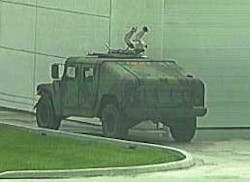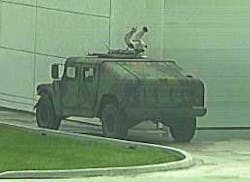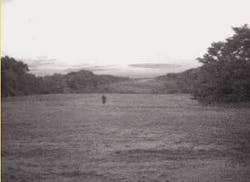Princeton, N.J. - The expansion of military efforts has resulted in a dramatic increase in the number of electro-optic (EO) systems installed on military hardware. Electro-optic imaging systems are now on everything from aircraft carriers to unmanned aerial vehicles (UAVs) to individual soldiers’ rifles and helmets. These EO systems not only enable the users to “see” their surrounding environment in the day or night, in low-light or no-light conditions, but also to get range information to the target and aim laser-guided weapons. The use of EO systems helps protect the soldier by enabling him to view the battlefield from a relatively safe distance or position while gaining critical information about the scene.
Many new EO systems have thermal cameras as their major imaging component. These cameras detect radiation of longer wavelengths than 3 microns, in either the midwave infrared (MWIR: 3 to 5 microns) or longwave infrared (LWIR: 8 to 12 microns), enabling the war fighter to see heat from people, buildings, or vehicles.
Traditionally, EO systems have visible cameras or intensified charged-coupled-device (I2CCD) cameras also, permitting the user to see the scene in a wavelength band similar to human vision or night-vision goggles. Electro-optic systems have begun to proliferate through the military, yet the systems, as they are currently configured, are not as useful in every situation as they could be. This is the reason that designers must consider other technology that expands the wavelength bands and enhances EO imaging system capabilities.
The largest drawback of thermal imagers is their inability to see laser designators and rangefinders. The three most common lasers in the field that are invisible to the eye, emit light at 850 nanometers, 1.06 microns, and at 1.54 microns (also known as “eye-safe” lasers). It is important to note that these wavelengths may vary slightly, contingent on the lasing material used.
null
The 1.54-micron lasers have many advantages to the military beyond being eye-safe and thereby protecting friendly soldiers from the reflected light. They are also invisible to the enemy because image-intensifier tubes cannot see them.
Currently, nearly all EO systems assume that lasers are properly aligned in the optical train and the laser spot is on the target. The laser spot is invisible to current thermal imagers employed in these EO systems. In addition, the optical alignment can be easily compromised in the heat of battle. The potential for misalignment is especially high on long-range targets where alignment is critical. Giving the operator the capability to image the actual laser spot on the correct target is critically important to minimize collateral damage or “friendly-fire” incidents.
An indium gallium arsenide (InGaAs) shortwave-infrared (SWIR) camera resolves this problem by expanding the EO system’s range to include these common laser wavelengths. These commercially available cameras have sensitivity ranges from 900 to 1700 nanometers with newer versions that extend the detection range from the visible to the near-infrared waveband regions (400 to 1700 nanometers).
The new, dual-wavelength visible/InGaAs MiniCamera from Sensors Unlimited offers added benefits for imaging operations and can be easily incorporated into the traditional EO imaging systems. The visible sensor can eliminate the need for a complementary-metal-oxide-semiconductor (CMOS) camera and the SWIR sensor can supplement the current thermal imaging system thus enabling the user to image the reflected light from currently used laser designators or laser range finders. As noted earlier, the shortwave infrared sensor can image the actual laser spot on the correct target, to help ensure that laser alignment is in place and substantially reduce the margin for error.
The option of adding only a SWIR camera is a relatively easy upgrade to an existing EO system because no custom optics are required. The SWIR sensor uses standard glass optics and can “share” the visible camera lenses. These cameras are small, compact, and as easy to operate as visible CMOS or CCD cameras. They require low power to output analog video as well 12- or 14-bit digital information to digital standards like Camera Link and RS-422.
The focal-plane arrays (FPAs) are uncooled, which means they operate at room temperature, eliminating the need for large vibration-prone sterling cycle-coolers or multistage thermoelectric coolers (TECs). Additionally, no infield NUCs (nonuniformity corrections) are necessary. The miniature SWIR cameras have no moving parts and can be installed in spaces where volume and weight is a consideration, such as helmets, mini or micro UAVs, gimballed mounts, or rifles.
The SWIR imagers are all-solid-state devices. InGaAs imagers can be hit with light many orders of magnitude beyond their saturation point for long periods of time with no detrimental effects.
There are other distinct advantages to imaging in the SWIR waveband, beyond seeing the lasers on the battlefield. Imagery in the short-wave infrared looks similar to visible imagery, making scene analysis and interpretation easier. The images from SWIR cameras show signs, roads, buildings and vegetation looking similar to visible imagery.
It is very easy to distinguish street lights and car brake lights, for example, making complex operations like driving or flying much simpler than with thermal imaging. Moreover, objects are visible in day and/or night, having the sun or only starlight illumination as the light source. The SWIR imager also works very well during the crossover points at dawn and dusk. Thermal imagers have difficulty during these times because of varying emissivities and cooling rates that cause a lack of contrast between objects in the scene. Camouflage patterns are also specifically designed to fool our eyes by minimizing the contrast on a given surface. In the short-wave IR waveband, the fabrics and paints used to camouflage objects have a different reflectivity, thus making them less effective.Dr. Martin H. Ettenbergis director of imaging products at Sensors Unlimited Inc. in Princeton, N.J. He can be contacted at [email protected].






